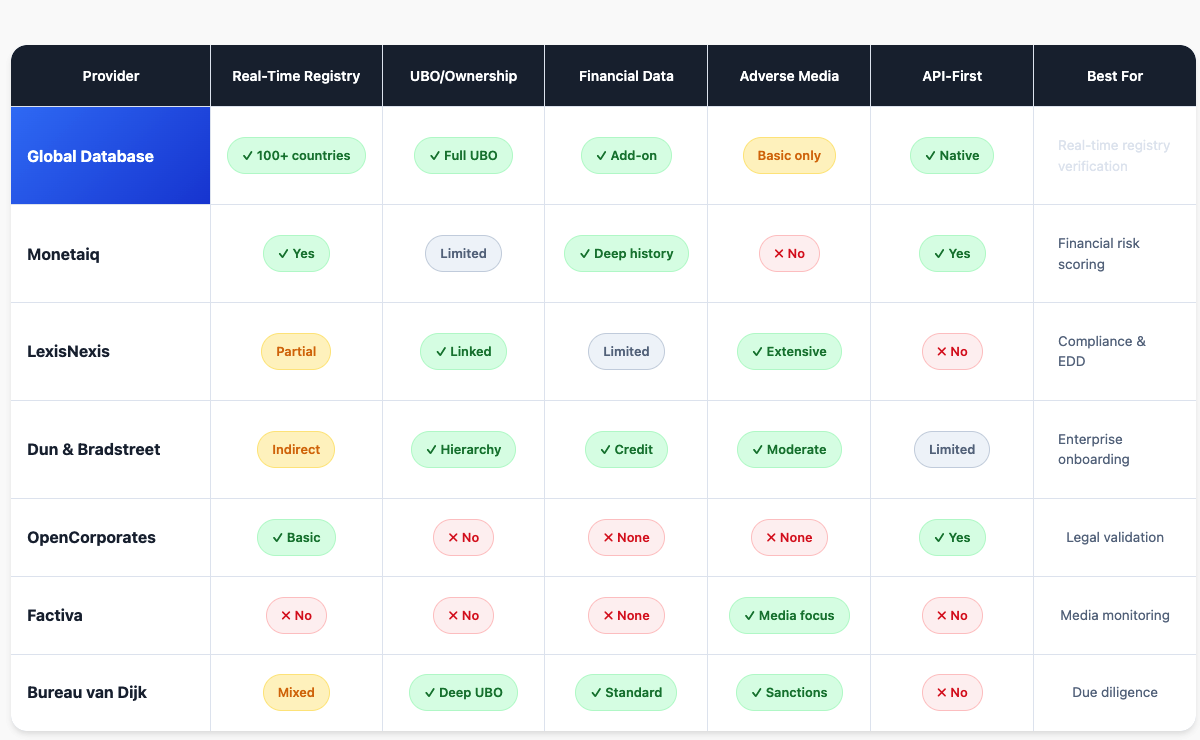
Making Sense of Private Company Financials: What’s Available, What’s Missing, and How to Fill the Gaps
1. Introduction
When it comes to company financial data, most tools and workflows are designed around public companies — where balance sheets, income statements, and KPIs are standardized, disclosed, and easily accessible.
But the real world isn’t just public.
If you’re working in risk analysis, onboarding, B2B sales, investment, or compliance, you’re likely dealing with millions of private companies across global markets. And that’s where the challenges begin.
Unlike public companies, private firms aren’t required to disclose detailed financials in many jurisdictions. Where data is available, it’s often outdated, incomplete, or reported using non-standard formats. That makes enrichment, risk modeling, and even simple segmentation difficult — especially at scale.
This article will break down:
- What financial data you can get from private companies (and where)
- What’s often missing or unreliable
- How Zephira.ai fills the gaps with real-time registry connections and structured enrichment
Whether you’re building onboarding flows, powering due diligence tools, or enriching CRM records, understanding the limitations — and solutions — around private company financials is critical.
Let’s dive in.
2. What Financial Data Is Typically Available for Private Companies?
Despite the challenges, many private companies are still required to file certain financial information — depending on their country, size, and legal structure. The key is knowing what’s available, where, and in what format.
Here’s what you can typically access through official business registries:
Core Financial Fields (When Available)
- Revenue (Turnover): Often available for mid-size and large entities; frequently missing for micro-enterprises.
- Net Profit / Net Income: Included in full accounts or simplified summaries depending on filing requirements.
- Total Assets: Common in balance sheets, though definitions may vary.
- Shareholder Funds / Equity: Key for understanding financial stability.
- Working Capital / Current Liabilities: Occasionally disclosed depending on country and entity size.
Types of Filings
- Full Financials: Submitted by larger companies and include profit & loss, balance sheet, and cash flow statements.
- Abbreviated or Micro-Entity Accounts: Often exclude revenue and profit figures — but may include balance sheet totals or capital structure.
- Consolidated Group Reports: Provided by parent companies for corporate group structures, mainly in the EU.
Country-Specific Examples
- United Kingdom: Companies House requires even small firms to file, though many submit abbreviated accounts with limited detail.
- France & Italy: Full financials are filed by most active companies, especially SAs and SRLs.
- United States: Private companies are not required to disclose financials publicly, unless regulated or acquired.
- Germany: GmbHs must file, but small entities can omit profit & loss figures.
Takeaway
The availability of private financial data is heavily shaped by local regulation, company size, and legal form — which makes normalization and enrichment critical if you’re building cross-border data products.
3. What’s Often Missing or Unreliable
Even when private companies file financials, the data is far from complete or standardized. Developers, analysts, and product teams working with international company data often run into the same problems — silent gaps that break scoring models, lead routing, or risk flags.
Here are the most common blind spots:
Missing Key Financial Indicators
- EBITDA, Gross Margin, Operating Income
Rarely included in simplified filings. Even when available, definitions vary and comparability suffers. - Cash Flow Statements
Almost always excluded from small-company filings, despite being critical for liquidity analysis. - Revenue & Profit Figures
In many countries, micro or small entities are exempt from disclosing them. Even mid-size companies may file incomplete or aggregated values.
Inconsistent Filing Periods
- Delayed Reporting
Financials are often filed 6–18 months after year-end, making them stale for real-time decisioning. - Fiscal Year Mismatch
Companies operate on different fiscal years, leading to inaccurate year-on-year comparisons if not normalized.
Currency & Scale Confusion
- Local Currency Without Conversion
Financials are usually reported in local currency, requiring conversion and metadata for proper analysis. - Unclear Units (Thousands? Millions?)
Some registries don’t clearly state whether figures are in absolute numbers, thousands, or millions — which can lead to critical misinterpretation.
Missing Size Indicators
- Employees Count
May be absent altogether, estimated, or disclosed in wide ranges (e.g., 11–50, 51–200), depending on the source. - Company Type Ambiguity
A company may appear large due to group structure, but files only minimal data at the local entity level.
Bottom Line
You can’t build a reliable risk model or enrichment engine with partial data. But you also can’t wait for global governments to fix filing rules.
That’s where normalization, enrichment, and intelligent estimation become essential.
4. Understanding Jurisdictional Variability
No two countries treat private company financials the same way. Some enforce strict filing rules even for small businesses. Others allow full exemption — or don’t require any financial disclosures at all.
If you’re building a global product, you must account for these jurisdictional differences — or risk inconsistent outputs and broken logic.
Here’s a snapshot of how transparency varies across key markets:
🇬🇧 United Kingdom
- Registry: Companies House
- Transparency Level: High
- Filing Rules: All limited companies must file annually.
- Caveat: Micro-entities can submit abbreviated accounts with no revenue/profit.
- Typical Data: Revenue, net profit, total assets, shareholder funds (varies by size).
🇩🇪 Germany
- Registry: Bundesanzeiger / Handelsregister
- Transparency Level: Moderate to low
- Filing Rules: GmbHs must file, but small companies can omit income statements.
- Caveat: Fines for non-compliance are common, but enforcement is inconsistent.
- Typical Data: Total assets, capital, but often no revenue or profit.
🇫🇷 France
- Registry: INPI / Infogreffe
- Transparency Level: Moderate to high
- Filing Rules: Most active companies (especially SARL, SA) must file full accounts.
- Caveat: Option to request confidentiality for certain documents.
- Typical Data: Revenue, net income, balance sheet, workforce.
🇺🇸 United States
- Registry: Varies by state (Delaware, Wyoming, etc.)
- Transparency Level: Very low
- Filing Rules: Private companies are not required to file financials publicly.
- Caveat: Financials may only be accessible via third-party sources or voluntary disclosures.
- Typical Data: Only available via enrichment, estimation, or M&A disclosures.
Takeaway
Each jurisdiction introduces unique legal, cultural, and technical challenges. That’s why registry integration alone isn’t enough — you also need a normalization engine that understands country-specific reporting logic, gaps, and filing thresholds.
5. How Zephira Bridges the Gap
At Zephira, we’ve built our infrastructure to do the heavy lifting when it comes to fragmented, inconsistent financial data — especially from private companies.
Instead of relying on scraped sources or shallow enrichment, Zephira connects directly to official registries in 100+ countries, applies deep normalization logic, and fills critical gaps using proprietary enrichment models.
Here’s how we make financial data usable — even when registry filings are limited or missing:
Direct Registry Integrations
- We access structured financial filings from national registries, including annual accounts, capital disclosures, and historical financials.
- Our system identifies the most recent filings, filters duplicates, and flags inactive or non-compliant entities.
Schema-Based Normalization
- All financial data is transformed into a standardized, developer-friendly schema, regardless of country of origin.
- Fields like revenue, net profit, total assets, shareholder funds, and EBITDA are consistently labeled and mapped.
- We also normalize fiscal years, currency, and units of measure to ensure clean analysis and comparison.
Enrichment & Estimation
- Where registries don’t disclose data (e.g., US private companies or micro-entities in Europe), we use modeled estimates based on:
- Website traffic
- Workforce size
- Industry benchmarks
- Corporate structure
- Enriched fields include estimated revenue, employee count, and growth flags — clearly labeled to distinguish from official data.
Continuous Updates
- Data is refreshed in near real-time, depending on local registry schedules.
- Any newly filed reports are instantly processed and made available via API.
Flexible Access via API
- Developers can query a company’s financial profile in real time.
- You can retrieve:
- The latest available financials
- A 5–20 year financial history, where available
- Both official and enriched indicators — clearly separated
By combining registry truth with smart enrichment, Zephira gives you the most complete, reliable, and scalable financial dataset on private companies — ready to plug into onboarding flows, credit models, investment platforms, or analytics dashboards.
6. Example Output: Private Company Financial Profile via API
Let’s look at what a real financial profile for a private company might look like when retrieved through the Zephira API.
This example shows how we deliver clean, normalized, and labeled data — with clarity on which fields are registry-sourced and which are enriched or estimated.
Sample API Call
http
CopyEdit
GET <https://api.zephira.ai/v1/company/lookup?registration_number=12345678&country=GB>
Sample API Response
json
CopyEdit
{
"legal_name": "Acme Technologies Ltd",
"country": "GB",
"status": "Active",
"incorporation_date": "2011-05-12",
"legal_form": "Private Limited Company",
"currency": "GBP",
"fiscal_year_end": "2023-12-31",
"financials": {
"year": 2023,
"source": "registry",
"revenue": 1520000,
"net_profit": 172000,
"total_assets": 490000,
"shareholder_funds": 310000,
"ebitda": null},
"estimates": {
"revenue_band": "1M–2M",
"employee_estimate": 18,
"revenue_source": "registry",
"employee_source": "enriched"
},
"meta": {
"data_last_updated": "2024-06-14",
"filing_delay_days": 138,
"registry_source": "Companies House (UK)"
}
}
Key Highlights
- Official financials are clearly flagged under financials and linked to the year and source.
- Estimated fields are separated under estimates with attribution (e.g., derived from website, traffic, or industry benchmarks).
- Currency and fiscal year are normalized, eliminating ambiguity for cross-market analysis.
- Data freshness is visible via data_last_updated and filing lag.
With this structure, developers, analysts, and risk teams can trust what’s behind each number — and automate workflows without manually checking source reliability.
7. Use Cases for Financial Data on Private Companies
Reliable financial data on private companies is no longer just a “nice to have” — it’s essential for powering decision-making across modern B2B platforms. From onboarding flows to investment analysis, normalized and enriched financials unlock serious value.
Here are some of the most common and impactful use cases:
1. Risk Scoring & Credit Assessment
- Determine credit limits based on revenue, assets, and shareholder equity
- Assess solvency using financial ratios derived from structured balance sheet data
- Flag high-risk entities with negative working capital or overdue filings
2. Vendor & Supplier Due Diligence
- Validate the financial health of suppliers, subcontractors, and service providers
- Prevent fraud or reputational risk by checking registry-sourced figures and status
- Use multi-year financial trends to assess long-term reliability
3. Investment Research & Market Analysis
- Compare private company growth, profitability, and margins within a target sector
- Identify promising acquisition targets or benchmark peers using global financial KPIs
- Normalize private vs public data to build consistent dashboards or scoring models
4. CRM & Customer Enrichment
- Enrich B2B lead profiles with revenue, employee estimates, and profit indicators
- Use financial filters to prioritize outreach (e.g., companies with >$10M revenue)
- Add scoring logic that adjusts based on real financial performance
5. Onboarding & KYB Workflows
- Automatically verify company size and activity status for regulatory checks
- Combine financials with ownership and registration data for complete KYB coverage
- Detect shell companies or inactive entities through missing or outdated filings
6. Automation in Fintech, SaaS, and Procurement Platforms
- Power decisioning engines with real-time financial metrics
- Set automated thresholds (e.g., reject companies under €100K turnover)
- Enable clients to build custom rules on top of normalized financial data
In short, clean financial data on private companies isn’t just useful — it’s foundational. Zephira makes it accessible, interpretable, and actionable for any product or workflow.
8. Final Thoughts
Getting financial data on private companies used to mean working with outdated PDFs, expensive providers, or incomplete spreadsheets — and still ending up with gaps you couldn’t explain or trust.
At Zephira, we’ve rethought this from the ground up.
By connecting directly to official registries in 100+ countries and combining that data with intelligent enrichment, we provide the most reliable, normalized, and developer-ready financial dataset on private companies — globally.
Whether you’re:
- Scoring risk in real time
- Enriching leads with revenue and employee data
- Automating onboarding and KYB flows
- Benchmarking market segments or deal targets
…Zephira gives you the tools to do it without guessing, without scraping, and without stitching together messy datasets.
Because even when the data isn’t perfect, the structure matters.
And that’s exactly what we deliver.
Frequently Asked Questions (FAQ)
1. Can you get financial data on private companies?
Yes — but availability depends on the country, company size, and legal structure. Some jurisdictions (like the UK or France) require private firms to file financials, while others (like the US) don’t. Zephira retrieves this data from official registries and enriches gaps when necessary.
2. What financial metrics are available for private companies?
Commonly available metrics include revenue, net profit, total assets, shareholder funds, and incorporation date. Other fields like EBITDA, cash flow, or employee count may be missing or need to be estimated.
3. How does Zephira handle missing financial data?
Zephira enriches incomplete records using proprietary models based on website traffic, industry benchmarks, and corporate structure. All estimated fields are clearly labeled and separated from official registry data.
4. Do private company financials include fiscal year and currency?
Yes. Zephira normalizes all financial data by aligning fiscal years and converting figures into a standard currency where needed, enabling consistent cross-border comparisons.
5. Is Zephira’s financial data available via API?
Absolutely. You can access registry-sourced and enriched financial data on private (and public) companies globally through a real-time API, designed for developers and product teams.
6. Can I access historical financials for private companies?
Yes — for countries where registries make past filings available (e.g. UK, France, Belgium), Zephira delivers up to 20 years of structured financial history via API or bulk data delivery.

